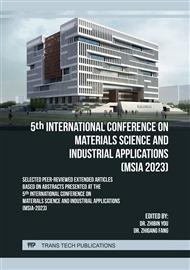[1]
TENG H S. Study on stress-strain field and microstructure of Inconel718 alloy treated by laser [D]. Master Degree Thesis, Yanshan University,2014.
Google Scholar
[2]
CAI Jianping, Liu Jianhua; Liu X L. Material Life Extension and Sustainable Development Material Environmental Adaptability Engineering [M]. Beijing: Chemical Industry Press, 2014.08. (in Chinese).
Google Scholar
[3]
Zhao R. Study on microstructure and properties of Inconel601H Ni-base alloy P-TiG Welding Joint [D]. Hebei University of Technology,2014.
Google Scholar
[4]
Zhao Xinbao, Yue Liang, Xia Wanshun, Yue Quanzhao, Bei Hongbin, Wei Hua, Wei Xiao, Zhang Ze. Effect of solution treatment on Microstructure and segregation of a Fourth generation Nickel-base single crystal superalloy [J]. Journal of electron microscopy,2020,39(05):462-469.
Google Scholar
[5]
Zhang Wenzhu, Xu Zhoufeng, Jiang Li. Effect of solution heat treatment on microstructure and properties of GH3535 alloy [J]. Rare metal materials and engineering,2016,45(06):1583-1587.
Google Scholar
[6]
Ding Yutian, Wang Xingmao, Meng Bin, Gao Yubi, Ma Yuanjun. Regulation GH3625 alloy seamless pipe structure and mechanical properties research [J]. Rare metal, 2019 lancet (03) : 274-282. The DOI: 10.13373/j.carol carroll nki CJRM. Xy18040014.
Google Scholar
[7]
Julien Favre, Damien Fabrègue, Eric Maire,Akihiko Chiba. Grain growth and static recrystallization kinetics in Co20Cr-15W-10Ni (L-605) cobalt-base superalloy[J]. Philosophical Magazine,2014,94(18).
DOI: 10.1080/14786435.2014.903342
Google Scholar
[8]
DAI X C. Effect of solution treatment on hardness of Inconel600 nickel-base alloy [J]. Casting technology,2018,39(08):1824-1827.
Google Scholar
[9]
Tian Ning, Tian Sugui, Yu Huichen, Meng Xianlin. Effect of solution temperature on creep properties of unidirectional solidified nickel base alloy [J]. Journal of materials and heat treatment,2014,35(07):86-93.
DOI: 10.1016/j.msea.2014.07.103
Google Scholar
[10]
Liu Tian, Cheng Xiaonong, Luo Rui, Zheng Qi, Wang Jiao, Chen Guang, Yang Qiao. Effect of solution treatment on microstructure and tensile strength of Cr18Ni31NbAl austenitic Stainless Steel [J]. The hot working processes, 2018,47 (24): 181-185. DOI: 10.14158 / j.carol carroll nki. 1001-3814.2018.24.045.
Google Scholar
[11]
Gao Yuguang, Liu Jing. Effect of solution treatment on microstructure and mechanical properties of 825 nickel-base alloy tube [C]/. Proceedings of 2015 Technical Innovation and Fine Production Technology Exchange Conference on Continuous Casting Equipment. [Publisher unknown], 2015: 346-350.
Google Scholar
[12]
Yang Jichun, Zhou Li, Dong Mengyao, Zhang Jian, Li Hongwei. Different nickel content in 316 austenitic stainless steel orthogonal experiment of solid solution treatment process [J]. Journal of thermal processing, 2015, 44 (8): 203-205 + 208. DOI: 10.14158 / j.carol carroll nki. 1001-3814.2015.08.060.
Google Scholar
[13]
Li Xiaobing, Li Wei. Solid solution temperature on the microstructure and hardness of high temperature alloy GH3600 effect [J]. Metal heat treatment, 2020, (6) : 51 and 55. DOI: 10.13251 / j.i SSN. 0254-6051.2020.06.011.
Google Scholar



